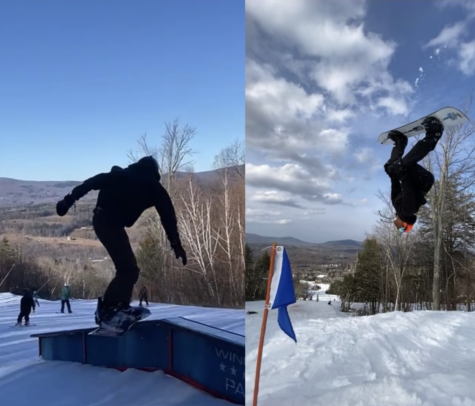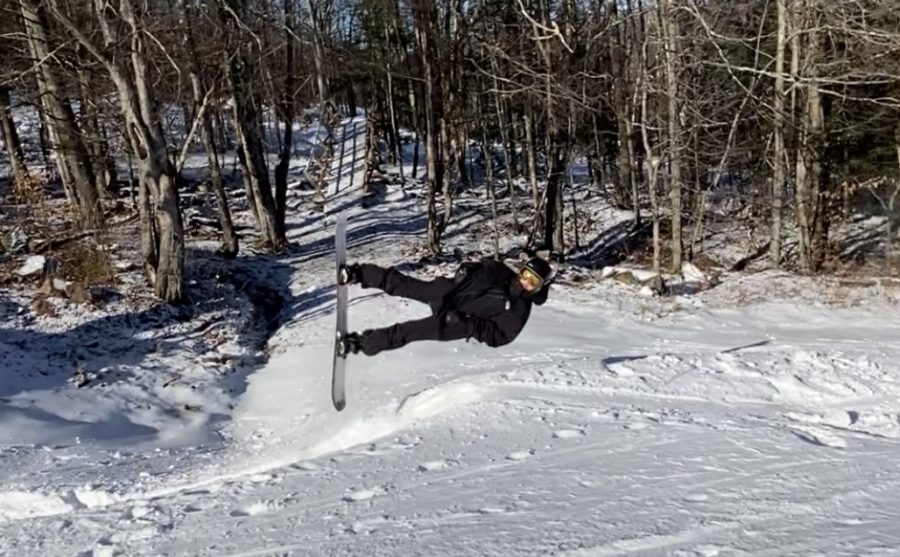Not So Bored on a Snowboard
My undercover account of snowboard culture.
Cameron Powers (used by permission)
Here is my first attempt at a “tame dog” (or front flip).
My body might be in physics class, but I’ve since left my mind on the slopes. So much so that I can still feel the fiberglass snowboard beneath my feet, resting on speckled stone floors – gray upon gray – to match my mood.
I am addicted to snowboarding. In hindsight, I knew I would be, back in November, when I chose snowboard culture as my prospective Science Survey newspaper article topic. But back then my imagination was resigned to Instagram Reels and faded memories; others would flip and I’d watch, maybe grin, and all the while think that I would join them soon. Then never actually try…was I ever, really, part of the culture?
I can now say, definitively, no. Not last year, when I was a solo rider. With an airpod in one ear, but no friends to hear with the other. I was never pushing the boundaries of my craft, and was really quite the layman, although, and ironically, a snowboard instructor by this point, with weekly access to the slopes that I routinely denied and passed up for naps.
I am glad to have since reformed, and for narrative’s sake, feel inclined to point out exactly when — December 18th, 2022 — at a corporate wellness clinic above all things. A member of the PSIA-AASI National Team, Brian Donovan, hit the slopes with a handful of instructors that fortuitously included me. The organization he works for – whose title is too long to be aesthetically unabbreviated – encourages and standardizes snowsports instruction worldwide. Now, along that same encouragement vein, here he was to help us hone our snowboarding for three hours. I knew this was my one chance to tick off my internal, Reels-inspired bucket list, and jumped at the chance to ask questions.
I will guiltily concede that my two proceeding questions took up the entire three hours. Yet in this time I learned three tricks. The first is called a frontside 180, a skill that requires a snowboarder to initiate an airborne, 180-degree spin by first swinging their shoulders around their body while mid-jump, and then following through with their legs. The second trick, a backside boardslide, is triggered when a snowboarder jumps or slides perpendicularly onto a feature (box, pill, rail … a hard, waxed surface, essentially). Whether assuming or remaining in this sideways position, which is undoubtedly awkward, it is nonetheless the snowboarder’s instinct to lift their toes to regain balance. I can confirm from experience that nothing feels worse.
BANG. Spine to the metal. Not until I rode in a group did I even try to surpass this once ominous, boardslide fear block. The third, most essential trick I learned on that cold, December morning was to man-up and make friends.

“Typically when skiers ride together they are very formal about it,” said Donovan. Snowboarders, he told the group, are more communal in that sense; we help each other ride. It’s part of the culture. “If I see my friend do something cool, I’ll ask them how they did it.”
About to fall out of my boardslide, and perhaps spinewards again, Donovan reminded me, “Pet the dog!” I bent my knees, outstretched my left arm to an imagined dog, and equilibrium returned at last! Hallelujah. The sensation may be difficult to imagine passively, but time slows with the perfect balance between board and metal underfoot. The slick and satisfying glide runs seemingly counter to Newtonian forces at every angle. Landing the front boardslide was a nice bullseye to hit in that regard.
“I love when students figure things out and then turn and look at you with a sense of pride and accomplishment,” Donovan later confessed to me. And with that said, I am glad to have delivered.
I had two fresh victories under my belt, and an itch for more. Whipping out a clean front 1 in a group became intensely gratifying, and the fact that the rest were simultaneously flipping did by no means detract from the experience…though maybe it should have. I would get there soon, I thought, and this time I meant it.
From then on, I woke up early, doubled my bucket list and finally made some friends. These were instructors with the same position and passions as me, with whom I could share cryptic and intellectually uninspired conversations on below themes:
“Try to cab 1 in switch so you can nose press your snapped tail;” “bone out that stale fish.”
Ultimately, these were friends with whom reps could be fun. Around them, waking up at six did not feel like a chore but rather a blessing. Around them, jumping off a cliff did not feel like a death sentence but instead the key to life.
Speeding on a snowboard feels great; cold air abrading your body and slicing your lungs, eye-balls pumped sizzling hot by adrenaline. But then you might add a sleek carved turn to the mix, your body dropping down to a few degrees above the snow, wedged into it by only a vertical inch-length of snowboard that cuts through it like butter. This will feel even better.
Perhaps you then swing this centripetal momentum into a lippy side-hit, throwing your shoulders back and around you, and relish in the weightlessness of the backflip. Stick the landing and enjoy the profanities of shocked, 10-year olds nearby. But best of all is to share these victories amongst friends. Camaraderie in its fittest form. The blinding euphoria that proceeds is incomparable to any other stimulus I’ve ever encountered.
My small new group of five or so have since dubbed our reps “laps at 8;” laps of the mountain we take at 8 A.M., before work – extended also to 3 P.M., after work, to make the most of every day. (i.e. Laps at 8? one of us will text the group chat, to which we must all respond yes, or get publicly shamed). This practice of ours was inspired by the hashtag #wherewereyouatthree, which is used to shame on a scale much larger than five or so. As Donovan (a subscriber) puts it:
“[The hashtag was] created by a group of instructors… the idea is that no matter if you had the greatest day or a tough day, you meet up with your friends and take a run or two together every day to celebrate and enjoy snowboarding. It’s important to connect with people and to get out on your snowboard to remind yourself of the love you have for our sport and our industry.”
These days, my love for the sport and industry is bordering upon impossible to forget. My city friends are fed up with my endless stories and my notebooks are fed up with my endless doodles. Every minute my feet spend away from snow is a minute spent restlessly. The nine-period school day feels thus like a lackluster joke in comparison.
However my face has cleared up, my procrastination erased, and my positivity, I hear, is commendable. The brilliance of snowboarding is that it is a feeling sport. Trust your body to send a trick; trust the snow to carve a turn. I cannot get enough. The more one thinks, the more they fracture the implied body-nature bond that is otherwise intoxicating; to bend wild to the will of the board.
The Bronx Science experience cultivates the mind only, and often, I feel over-cultivates. Without a balance of stimulus other than intellect, the brain forms tunnel vision, deeming life to be GPA-synonymous. In that sense, snowboard culture is the very best suited antidote. I will live by it until the snow melts.
“It’s important to connect with people and to get out on your snowboard to remind yourself of the love you have for our sport and our industry,” said Brian Donovan.
Yasmine Salha is an Editor-in-Chief for ‘The Science Survey.’ She is a proponent of accessible journalism, and loves to simplify complex and controversial...

